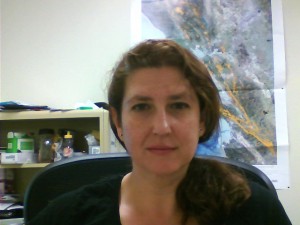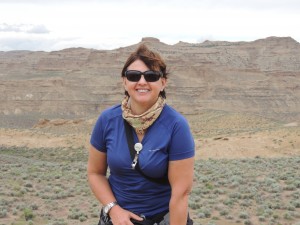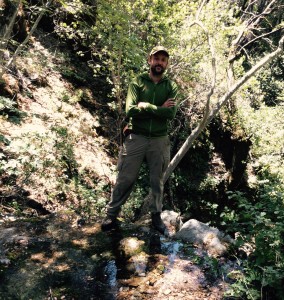The Department of Geology is pleased to introduce several new members. Read more about their research and specialties.
Dr. Claudia Adam
 Claudia Adam obtained her PhD from the Institute of the Physics of the Globe, in Paris (IPGP). While at IPGP, she worked on the processing and interpretation of geophysical data, in order to constrain the compensation mechanisms involved during intraplate volcanism emplacement in French Polynesia. After her PhD, she moved to Japan where she conducted a three year post-doctorate at JAMSTEC, Yokosuka. During this period she began modeling mantle dynamics based on tomography models developed by the Japanese team. The results show that a direct link exists between mantle dynamics and surface observations. Indeed, the dynamic models can account for the observed depth anomalies, or swells, as well as for the volcanism emplacement. At the broader scale of the South Pacific Superswell, the dynamic models can also account for geoid anomalies. After that, Claudia moved to Portugal, where she worked at the Centro de Geofisica de Evora as a research scientist. During this period, she was investigating the relationship between mantle dynamics and the characteristics of the Azores plateau. For this last topic, she was awarded a $180,000 research grant -OREAZ project. This study showed that the stresses induced by mantle convection can account for the rifting regime observed over the Azores plateau and the Terceira Rift, and its consequences in terms of surface morphology and seismicity. In 2013, Claudia began working as a research scientist at Virginia Tech. Her research goals were to further investigate the links between mantle dynamics and surface observations, but for a wider range of tectonic settings and at different scales. For this purpose she developed a method which allows a more realistic use of tomography models by coupling them with thermodynamic constrains. One of the projects Claudia Adam would like to develop in the near future is to constrain the structure and dynamics of the sub-continental lithospheric mantle under the North American continent.
Claudia Adam obtained her PhD from the Institute of the Physics of the Globe, in Paris (IPGP). While at IPGP, she worked on the processing and interpretation of geophysical data, in order to constrain the compensation mechanisms involved during intraplate volcanism emplacement in French Polynesia. After her PhD, she moved to Japan where she conducted a three year post-doctorate at JAMSTEC, Yokosuka. During this period she began modeling mantle dynamics based on tomography models developed by the Japanese team. The results show that a direct link exists between mantle dynamics and surface observations. Indeed, the dynamic models can account for the observed depth anomalies, or swells, as well as for the volcanism emplacement. At the broader scale of the South Pacific Superswell, the dynamic models can also account for geoid anomalies. After that, Claudia moved to Portugal, where she worked at the Centro de Geofisica de Evora as a research scientist. During this period, she was investigating the relationship between mantle dynamics and the characteristics of the Azores plateau. For this last topic, she was awarded a $180,000 research grant -OREAZ project. This study showed that the stresses induced by mantle convection can account for the rifting regime observed over the Azores plateau and the Terceira Rift, and its consequences in terms of surface morphology and seismicity. In 2013, Claudia began working as a research scientist at Virginia Tech. Her research goals were to further investigate the links between mantle dynamics and surface observations, but for a wider range of tectonic settings and at different scales. For this purpose she developed a method which allows a more realistic use of tomography models by coupling them with thermodynamic constrains. One of the projects Claudia Adam would like to develop in the near future is to constrain the structure and dynamics of the sub-continental lithospheric mantle under the North American continent.
Dr. Aida Farough
 Dr. Farough is a new instructor in the department with primary responsibility for teaching a range of introductory-level courses. She received her M.S. and Ph.D. in geophysics from the Department of Geosciences at Virginia Tech. Her primary research interests are multidisciplinary in areas of applied geophysics, geochemistry, mineral physics and rock mechanics. A particular focus is in the area of experimental petrology, and the evolution of hydraulic properties of rocks during water-rock interactions. She has also worked on numerical modeling of fluid flow and heat transfer at mid ocean ridges, characterizing magma-driven hydrothermal systems and defining the maximum depth of biological activity. During the course of her career she has collaborated with scientists from NASA and the USGS. She is a gemstone enthusiast and is keen to increase her knowledge of gemstone identification techniques.
Dr. Farough is a new instructor in the department with primary responsibility for teaching a range of introductory-level courses. She received her M.S. and Ph.D. in geophysics from the Department of Geosciences at Virginia Tech. Her primary research interests are multidisciplinary in areas of applied geophysics, geochemistry, mineral physics and rock mechanics. A particular focus is in the area of experimental petrology, and the evolution of hydraulic properties of rocks during water-rock interactions. She has also worked on numerical modeling of fluid flow and heat transfer at mid ocean ridges, characterizing magma-driven hydrothermal systems and defining the maximum depth of biological activity. During the course of her career she has collaborated with scientists from NASA and the USGS. She is a gemstone enthusiast and is keen to increase her knowledge of gemstone identification techniques.
Dr. Karin Goldberg
 Karin Goldberg has a Bachelor´s degree in Geology from the Federal University of Rio Grande do Sul (1992) and Master´s degree in Sedimentary Geology from Unisinos (1995) in Brazil, and a PhD degree in Geophysical Sciences (2001) from the University of Chicago, USA. She has worked as a geologist at the Brazilian Geological Survey in the Amazon and for the past 15 years she has been a lecturer and researcher in private and public universities in Southern Brazil, working in Petroleum Geology and Paleoclimatology.
Karin Goldberg has a Bachelor´s degree in Geology from the Federal University of Rio Grande do Sul (1992) and Master´s degree in Sedimentary Geology from Unisinos (1995) in Brazil, and a PhD degree in Geophysical Sciences (2001) from the University of Chicago, USA. She has worked as a geologist at the Brazilian Geological Survey in the Amazon and for the past 15 years she has been a lecturer and researcher in private and public universities in Southern Brazil, working in Petroleum Geology and Paleoclimatology.
She has taught undergraduate courses on Depositional Environments, Sedimentary Petrology and Mapping in Sedimentary Terrains, and a graduate course on Paleoclimatology. She has supervised more than a dozen undergraduate senior thesis and graduate students at M.Sc. and Ph.D. levels in the broad area of Sedimentology-Stratigraphy and Petroleum Geosciences.
She has carried out research projects in Sedimentary Geology and Petroleum Geology, working with clastic, carbonate and evaporite sedimentology, depositional systems, sedimentary facies, diagenesis and reservoir characterization.Most of the research projects that she has participated in over the past 10 years were partially or totally funded by petroleum companies such as Petrobras, BG Group and Chevron, with research scopes in Exploration and Production. The differential in her research projects has been the integration of tools in different scales (stratigraphic-sedimentologic and petrologic) to address a variety of geologic issues in several Brazilian basins, combining field skills (drill core and outcrop data) with a broad range of analytical methods (petrology, paleontology and geochemistry).
Dr. Brice Lacroix
 Brice obtained a Ph.D from the University of Franche Comté (France) and from the University of Barcelona (Spain). His Ph.D dealt with the fluid rock interaction and the mineralogical processes associated with the emplacement of thrust faults. In 2011 he joined the University of Lausanne where he worked with Pro. Torsten Vennemann on developing a thermometer based on oxygen fractionation between quartz and chlorite. In 2013 he joined the structural geology group from the University of Michigan where he worked with Prof. Niemi on the clumped isotope in order to unravel the paleoelevation of the western US. Brice also worked in mineral exploration in Europe, East Africa and Canada. His current research focuses on fault zone emplacement and especially the transfer of fluid along these crustal structures. He is currently working on different research projects in California, Canada, Morocco, Tanzania and Europe. More information about his research are present on his website here.
Brice obtained a Ph.D from the University of Franche Comté (France) and from the University of Barcelona (Spain). His Ph.D dealt with the fluid rock interaction and the mineralogical processes associated with the emplacement of thrust faults. In 2011 he joined the University of Lausanne where he worked with Pro. Torsten Vennemann on developing a thermometer based on oxygen fractionation between quartz and chlorite. In 2013 he joined the structural geology group from the University of Michigan where he worked with Prof. Niemi on the clumped isotope in order to unravel the paleoelevation of the western US. Brice also worked in mineral exploration in Europe, East Africa and Canada. His current research focuses on fault zone emplacement and especially the transfer of fluid along these crustal structures. He is currently working on different research projects in California, Canada, Morocco, Tanzania and Europe. More information about his research are present on his website here.